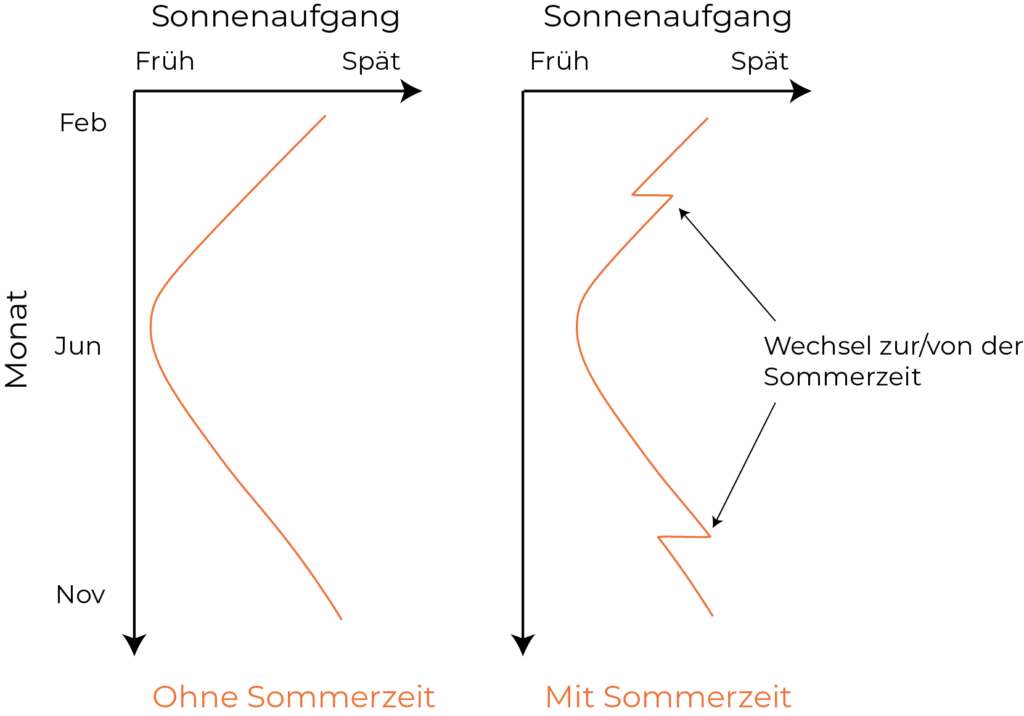When clocks are set forward by an hour in spring or back by an hour in autumn, our biological rhythm can fall out of sync. This can have negative effects of daylight saving time on health
The transition to daylight saving time in spring is particularly difficult, as we lose an hour of sleep, which we often chase for days or even weeks. Night owls, or late chronotypes, suffer the most, as the new time is even more out of sync with their internal clock compared to early risers. The consequences can be compared to jetlag [1].

Studies show that turning the clocks back in autumn causes fewer problems [1]. According to experts, this is because most people’s internal clocks are already running behind.
Effects of daylight saving time on health
The most common consequences of the time change are fatigue and low mood, which can last for days to weeks in sensitive individuals. Our internal clock controls what the body and brain do at specific times of the day. When it gets thrown off, issues can arise that affect mental and physical functions [2]. For example, several studies have shown that the rate of heart attacks increases in the days following the springtime change. On the Monday after the time change, heart attack rates were found to be 24% higher than in other weeks [3]. Traffic accidents also increase, and sadly, so do suicide rates [4,5]. Other studies show less clear results [6], but overall, it seems evident that the time shift has health effects.
Moreover, our cognitive performance and concentration can also be negatively affected by the time change. For example, after the spring change, employees tend to “cyberloaf” more—doing other things on the internet instead of their actual work [7]. A study of American students showed even more dramatic results: in states that regularly switch to daylight saving time, students perform worse in standardized tests [8].
Our Checklist for Adjusting to Daylight Saving Time
How can you best overcome the time change? A few simple measures can make a big difference. The following guide will show you how to master the time change weekend by adjusting your internal clock forward.
Saturday
- Immediately after getting up, go outside into the fresh air.
- Spend at least 1 hour outdoors in the morning, for example, in the garden or walking in the park.
- If you exercise, do it in the morning or early afternoon, not later.
- Eat dinner half an hour earlier than usual.
- Avoid artificial light sources 2 hours before bed as much as possible. If not possible, reduce the brightness to a minimum—candles are allowed.
Sunday
- Immediately after getting up, go outside into the fresh air.
- Spend at least 1 hour outdoors in the morning, ideally doing physical activity (e.g., running, cycling, walking). This not only helps adjust your internal clock but also helps you fall asleep in the evening despite the earlier time.
- Have your meals according to the new time. Avoid eating late in the evening.
- Minimize artificial light in the evening. An offline evening, such as a warm shower or bath an hour before bed, can help you sleep better.
Generally, it’s recommended to gradually adjust your routines to the new time. The earlier you start moving your bedtime forward, the easier the transition will be.
If you typically react strongly to the time change, try to avoid driving or engaging in dangerous activities during the first few days. This can help you avoid accidents, which are more likely during this period.
Why do we need to change the time at all?
Why did politicians originally decide on daylight saving time? The clue lies in the English name: “Daylight saving time”—meant to extend daylight hours and ultimately save energy. In 1996, daylight saving time was standardized across the EU, so all member states now change their clocks on the last Sunday in March and the last Sunday in October. Overall, about 70 countries implement this measure to save energy. However, this main reason for daylight saving time is now disputed: Germany’s Federal Environment Agency found that the energy savings are offset by the need for heating in the early morning hours [9]. Many researchers are now advocating for the abolition of daylight saving time. In 2018, the EU conducted an online survey where 84% of the 4.6 million respondents supported its abolition. The EU responded by deciding to hold the last time change in 2021, leaving it up to the states to choose whether to remain on standard time or daylight saving time [10]. Thus, March or October 2021 would have been the last time the clocks were changed. However, some governments, like Germany’s, insist on a prior investigation by the European Commission. A comprehensive impact assessment is considered essential before making such a far-reaching decision, but the Commission refuses to provide it. Therefore, it might still be a while before our clocks are changed for the last time [11].
References
[1] Thomas Kantermann, Myriam Juda, Martha Merrow, Till Roenneberg; The Human Circadian Clock’s Seasonal Adjustment Is Disrupted by Daylight Saving Time; Current Biology, Volume 17, Issue 22, 2007, Pages 1996-2000, ISSN 0960-9822, https://doi.org/10.1016/j.cub.2007.10.025.
[2] Manfredini R, Fabbian F, Cappadona R, Modesti PA. Daylight saving time, circadian rhythms, and cardiovascular health. Intern Emerg Med. 2018;13(5):641-646. https://doi.org/10.1007/s11739-018-1900-4
[3] Sandhu A, Seth M, Gurm HS; Daylight savings time and myocardial infarction, Open Heart 2014;1:e000019. https://doi.org/10.1136/openhrt-2013-000019
[4] A Chronobiological Evaluation of the Acute Effects of Daylight Saving Time on Traffic Accident Risk; Fritz, Josef et al.; Current Biology, Volume 30, Issue 4, 729 – 735.e2
[5] Berk, Michael, Dodd, Seetal, Hallam, Karen, Berk, L, Gleeson, John and Henry, M (2008) Small shifts in diurnal rhythms are associated with an increase in suicide: The effect of daylight saving. Sleep and Biological Rhythms, 6 (1). pp. 22-25. ISSN 1446-9235
[6] Arthur Huang, David Levinson; The effects of daylight saving time on vehicle crashes in Minnesota; Journal of Safety Research, Volume 41, Issue 6, 2010, Pages 513-520, ISSN 0022-4375, https://doi.org/10.1016/j.jsr.2010.10.006.
[7] Wagner, D. T., Barnes, C. M., Lim, V. K. G., & Ferris, D. L. (2012). Lost sleep and cyberloafing: Evidence from the laboratory and a daylight saving time quasi-experiment. Journal of Applied Psychology, 97(5), 1068–1076. https://doi.org/10.1037/a0027557
[8] Gaski, J. F., & Sagarin, J. (2011). Detrimental effects of daylight-saving time on SAT scores. Journal of Neuroscience, Psychology, and Economics, 4(1), 44–53. https://doi.org/10.1037/a0020118
[9] https://www.umweltbundesamt.de/sites/default/files/medien/publikation/long/3535.pdf
[10] https://ec.europa.eu/germany/news/20180831-konsultation-sommerzeit_de
[11] WAZ. https://www.waz.de/politik/eu-der-bizarre-streit-um-das-ende-der-zeitumstellung-id231854187.html


